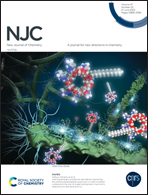The promotion effect of Sn on Cr/KIT-6 for the catalytic combustion of chlorobenzene†
Abstract
In this study, a SnCr/KIT-6 catalyst was synthesized by the incipient wetness impregnation method, and its performance was studied for the catalytic oxidation of chlorobenzene (CB). In addition, the activity, stability, physical structure, valence state change, chlorine deposition, and surface intermediates of the catalyst were analyzed using XRD, N2 adsorption–desorption analysis, H2-TPR, O2-TPD, TEM, XPS, and in situ FTIR spectroscopy. The experimental results revealed that the introduction of Sn can effectively improve the activity and chlorine resistance of the Cr/KIT-6 catalyst. According to T90 (temperature for the CB conversion of 90%), the catalyst exhibited the highest activity at a Sn/(Cr + Si) molar ratio of 0.15, which led to a CB conversion of greater than 65% for 100 h at T80. The introduction of Sn clearly promoted the dispersion of surface oxides and increased the content of highly oxidizing species (Cr6+). The results also suggested that the introduction of Sn promotes the dispersion of CrOx on the carrier (the major active species in CB degradation), rearranges the valence distribution via the redox equilibrium of 3Sn4+ + 2Cr3+ ↔ 2Cr6+ + 3Sn2+, and increases the surface Cr6+ content. The formation of a SnO2–CrOx solid solution improved the redox ability of the composite catalyst and reduced the deposition of the surface-deposited species (especially chlorine species) on the catalyst surface, resulting in the enhanced catalytic performance of the SnCr/KIT-6 catalyst toward the oxidation of CB.



 Please wait while we load your content...
Please wait while we load your content...